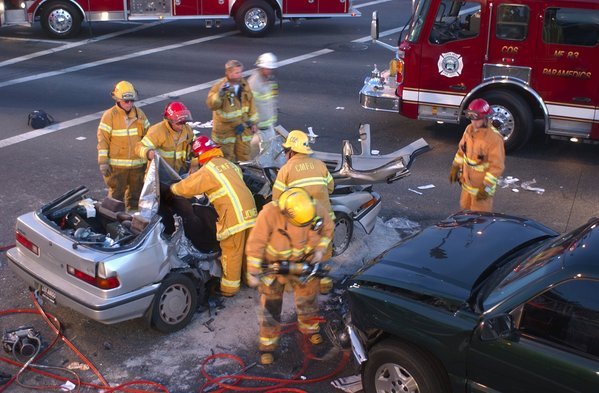Woodland Hills personal injury attorney Barry P. Goldberg has become a leading authority on Uninsured and Underinsured Motorist Law in California. “Stacking” Uninsured Motorist policies is not permitted in California and the “Underinsured” motorist issues created are extremely unfair to injured and insured drivers. The law in this area is tricky and unfair.
As a result, the insurance companies are regular subscribers to Mr. Goldberg’s Blog posts and articles in order to correctly interpret tricky areas of Uninsured and Underinsured Motorist law. Also, many California personal injury attorneys call Mr. Goldberg directly to obtain advice in this area in order to adequately represent their injured clients with Uninsured and Underinsured Motorist problems. The everyday auto insurance situations should not require specialized expertise—but, it does!
Here are some often repeated examples:
One of the At-Fault Parties has a Liability Policy Equal to UM Policy-No “Stacking”
My client was a passenger in party one’s vehicle and was one of many persons injured in a very serious accident with at fault party number two’s uninsured vehicle. Both party one and party two were at fault. The client received party number one’s per person insurance liability limit of $15,000. Since the client did not receive any Uninsured Motorist benefits under party one’s insurance policy, the client contended that he should be able to make a recovery under his own personal Uninsured Motorist policy. Arguing that he was not “made whole,” the client reasoned that this was not contrary to the “anti-stacking” provisions of the Uninsured Motorist laws because she was not receiving any other Uninsured Motorist benefits.
The Court held that the client was not eligible to receive benefits from her own policy. Since her Uninsured Motorist policy was equal to party one’s policy, further payment would represent an actual stacking of Uninsured Motorist benefits, contrary to §11580.2(q). See, Interinsurance Exch. Of Automobile Club of So. Calif. v. Alcivar (1979) 95 Cal. App. 3d, 252.
Passenger of a Partially Liable Driver—No UM and No “Stacking”
My injured client was hurt in a two vehicle accident as a passenger in party number two’s vehicle. Both party number one and party number two were equally at fault for the accident. The client’s total damages were in excess of $120,000. The client accepted a per person policy limit of $50,000 from party number two’s insurer. Party number one was uninsured.
My client contended that since the uninsured party number one caused damages in excess of $60,000, that her own Uninsured Motorist policy with limits of $100,000 per person should be available. There was some confusion whether the client was entitled to $10,000—the difference between $50,000 received from party two’s insurer and her own $60,000 policy limit; or $60,000 representing the damages caused by the Uninsured Motorist number one; or $70,000—the $60,000 Uninsured Motorist limit and the $10,000 difference between the amount received and the balance of her Underinsured Motorist limit.
The Court held that the client was limited to the $10,000 balance under his Underinsured Motorist Policy as to vehicle number two. Applying §11580.2(p)(4), the Court reasoned that the client’s insurer was entitled to a credit for all sums received from all parties legally liable. See, Holcomb v. Hartford Ins. Co. (1991) 230 Cal.App.3d, 1000.
One of the “quirks” in the Court’s reasoning is that if vehicle number two had a $60,000 or greater per person policy instead of $50,000, Uninsured Motorist law would have applied rather than the “Underinsured Motorist” law. In that case, the client would have received all her damages up to $120,000– $60,000 from party number two’s policy as well as $60,000 from her own Uninsured motorist policy!
Not “Underinsured” even though Client Does Not Receive All the 3rd Party Policy Limits.
In my practice, this scenario happens all the time. My recent clients will recognize this situation! No “stacking” of UM benefits if your UM policy limits match the 3rd party limits, but you still receive less than full payment of the 3rd party limits.
For example, the client is one of several people injured by a 3rd party who only has a California minimum policy of $15,000 per person, $30,000 per accident. The client’s damages are well in excess of the $15,000 per person 3rd party policy limit. Because there are several victims, the 3rd party’s minimum policy limit is apportioned pro-rata among the several victims. In this case, the client only received $10,000, instead of the maximum per person minimum limit of $15,000.
The client contended that she was entitled to obtain the $5,000 difference as between her own Underinsured Motorist policy and the $10,000 she recovered from the 3rd party’s policy. The Court held that the 3rd party vehicle was not “underinsured” according to the wording of the Uninsured Motorist statute. Since the 3rd party was not “underinsured,” it did not matter what amount was actually recovered by the client. This is a classic case of a client not “getting what they paid for.” As discussed below, there are movements in the legislature to remedy this inequity. See, Schweitwerman v. Mercury Ins. Co. (1991) 229 Cal.App.3rd 1044.
Conclusion
Many states allow what is known as “Stacking” in order to eliminate some of these unfair situations. Essentially, it allows the policy holder to get what he or she pays for—a policy of insurance to protect themselves regardless of the amount of the 3rd party liability policy. In effect, the policy you buy “Stacks” on top of the other party’s insurance. In my opinion, this is easy and fair.
Until the California automobile insurance system is overhauled, there will continue to be problems relating to Stacking.








